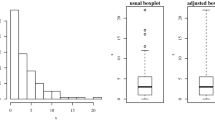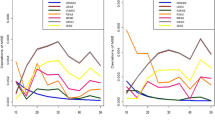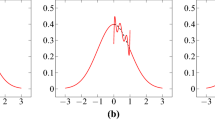Abstract
In this paper, we propose three simple closed form estimators for a class of log-symmetric distributions on \({\mathbb {R}}^{+}\). The proposed methods make use of some key properties of this class of distributions. We derive the asymptotic distributions of these estimators. The performance of the proposed estimators are then compared with those of the maximum likelihood estimators through Monte Carlo simulations. Finally, some illustrative examples are presented to illustrate the methods of estimation developed here.
Similar content being viewed by others
References
Bader S, Priest A (1982) Statistical aspects of fiber and bundle strength in hybrid composites. In: Hayashi T, Katawa K, Umekawa S (eds) Progress in science and engineering of composites. ICCM-IV, Tokyo, pp 1129–1136
Balakrishnan N, Zhu X (2014) An improved method of estimation for the parameters of the Birnbaum–Saunders distribution. J Stat Comput Simul 84:2285–2294
Birnbaum ZW, Saunders SC (1969) A new family of life distributions. J Appl Probab 6:319–327
Crow EL, Shimizu K (eds) (1988) Lognormal distributions: theory and applications. Marcel Dekker, New York
Díaz-García JA, Leiva V (2005) A new family of life distributions based on elliptically contoured distributions. J Stat Plan Inference 128:445–457
Engelhardt M, Bain LJ, Wright FT (1981) Inferences on the parameters of the Birnbaum–Saunders fatigue life distribution based on maximum likelihood estimation. Technometrics 23:251–256
Fang KT, Kotz S, Ng KW (1990) Symmetric multivariate and related distributions. Chapman & Hall, London
Gastwirth JL, Cohen ML (1970) Small sample behavior of some robust linear estimators of location. J Am Stat Assoc 65:946–973
Hinkley DV, Revankar NS (1977) Estimation of the Pareto law from underreported data. J Econom 5:1–11
Hodges JL, Lehmann EL (1963) Estimates of location based on rank tests. Ann Math Stat 34:598–611
Johnson NL, Kotz S, Balakrishnan N (1994) Continuous univariate distributions, vol 1, 2nd edn. Wiley, New York
Johnson NL, Kotz S, Balakrishnan N (1995) Continuous univariate distributions, vol 2, 2nd edn. Wiley, New York
Jones MC (2008) On reciprocal symmetry. J Stat Plan Inference 138:3039–3043
Kleiber C, Kotz S (2003) Statistical size distributions in economics and actuarial sciences. Wiley, Hoboken
Marshall AW, Olkin I (2007) Life distributions: structure of nonparametric, semiparametric, and parametric families. Springer, New York
McCool JI (1974). Inference techniques for Weibull populations. Aerospace Research Laboratories Report ARL TR 74-0180, Wright-Patterson AFB, Ohio
Ng HKT, Kundu D, Balakrishnan N (2003) Modified moment estimation for the two-parameter Birnbaum–Saunders distribution. Comput Stat Data Anal 43:283–298
Puig P (2008) A note on the harmonic law: a two-parameter family of distributions for ratios. Stat Probab Lett 78:320–326
R-Team (2016) R: a language and environment for statistical computing. R Foundation for Statistical Computing, Vienna, Austria
Rieck JR, Nedelman JR (1991) A log-linear model for the Birnbaum–Saunders distribution. Technometrics 33:51–60
Serfling R (2002) Efficient and robust fitting of lognormal distributions. N Am Actuar J 6:95–109
Uppuluri VRR (1981) Some properties of log-Laplace distribution. In: Patil GP, Taillie C, Baldessari B (eds) Statistical distributions in scientific work, vol 4. D. Reidel, Dordrecht, pp 105–110
Vanegas LH, Paula GA (2016) Log-symmetric distributions: statistical properties and parameter estimation. Braz J Probab Stat 30:196–220
Wang M, Park C, Sun X (2015) Simple robust parameter estimation for the Birnbaum–Saunders distribution. J Stat Distrib Appl 2:14
Acknowledgements
We thank the associate editor and the reviewer for the constructive comments.
Author information
Authors and Affiliations
Corresponding author
Appendices
Appendix 1: Asymptotic joint distribution of \(\widetilde{\nu }\) and \(\widetilde{\theta }\)
Let \(\mathbf{X}=(X_{1},\ldots ,X_{n})^{\top }\) be independent and identically distributed random variables with log-symmetric distribution. Consider
From the strong law of large numbers, it is known that S and \(R^{-1}\) converge almost surely to E[X] and \(E[X^{-1}]\), respectively. Also from the central limit theorem, we readily observe that S and \(R^{-1}\) are asymptotically normally distributed. Note that the vector \((S,R^{-1})^{\top }\) is bivariate normally distributed, that is,
We now need to find the asymptotic joint distribution of \(\widetilde{{\theta }} = f_1(S, R)\) and \(\widetilde{\nu } = f_2(S, R)\). For this purpose, we make use of the delta method. Suppose \({\varvec{X}} = (x_1, x_2)^{\top }\), \({\varvec{\eta }}\) and \({\varvec{\Sigma }}\) are such that \(\sqrt{n}({\varvec{X}} - {\varvec{\eta }})\mathop {\rightarrow }\limits ^{d}\mathrm{N}\left( 0,{\varvec{\Sigma }}\right) \). Let \(f = (f_1(x_1, x_2), f_2(x_1, x_2))^{\top }\) be a mapping from \({\mathbb {R}}^{2}\) to \({\mathbb {R}}^2\), where each \(f_i\) is differentiable at \({\varvec{\eta }}\). Let \({\mathbf {D}}\) be the Jacobian matrix of f with respect to \({\varvec{X}}\). Then, \(\sqrt{n}(f({\varvec{X}}) - f({\varvec{\eta }}))\mathop {\rightarrow }\limits ^{d}\mathrm{N}\left( 0,{\mathbf {D}} {\varvec{\Sigma }} {\mathbf {D}}^{\top }\right) \).
Thus, \(\sqrt{n}\left( f\left( R, S\right) - {(\theta , \nu )}^{\top }\right) \mathop {\rightarrow }\limits ^{d}\mathrm{N}\left( 0,{\mathbf {D}} {\varvec{\Sigma }} {\mathbf {D}}^{\top }\right) \), with
Appendix 2: Asymptotic distribution of \(\widetilde{\nu }_{\star }\)
First, note that
and
These expressions yield
Upon using Taylor expansion, we have
where \(g'(\cdot )\) and \(g''(\cdot )\) denote the first and second derivatives of the function of \(g(\cdot )\). We thus obtain the asymptotic distribution of \(\widetilde{\nu }_{\star }\) as
We also obtain the bias of \(\widetilde{\nu }_{\star }\) as
Appendix 3: R scripts
In this appendix, we present some R codes used in Sect. 5.


Rights and permissions
About this article
Cite this article
Balakrishnan, N., Saulo, H., Bourguignon, M. et al. On moment-type estimators for a class of log-symmetric distributions. Comput Stat 32, 1339–1355 (2017). https://doi.org/10.1007/s00180-017-0722-6
Received:
Accepted:
Published:
Issue Date:
DOI: https://doi.org/10.1007/s00180-017-0722-6




